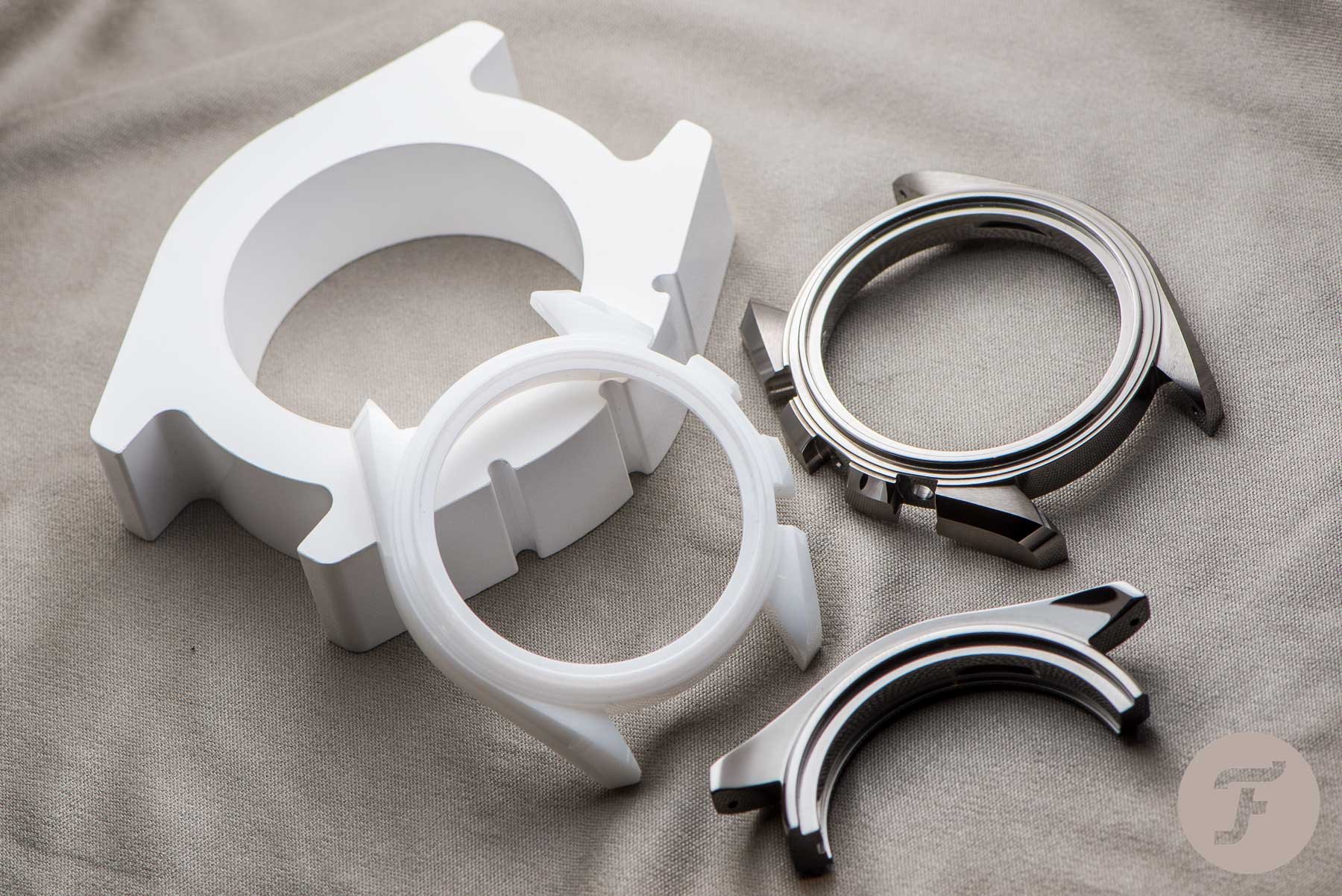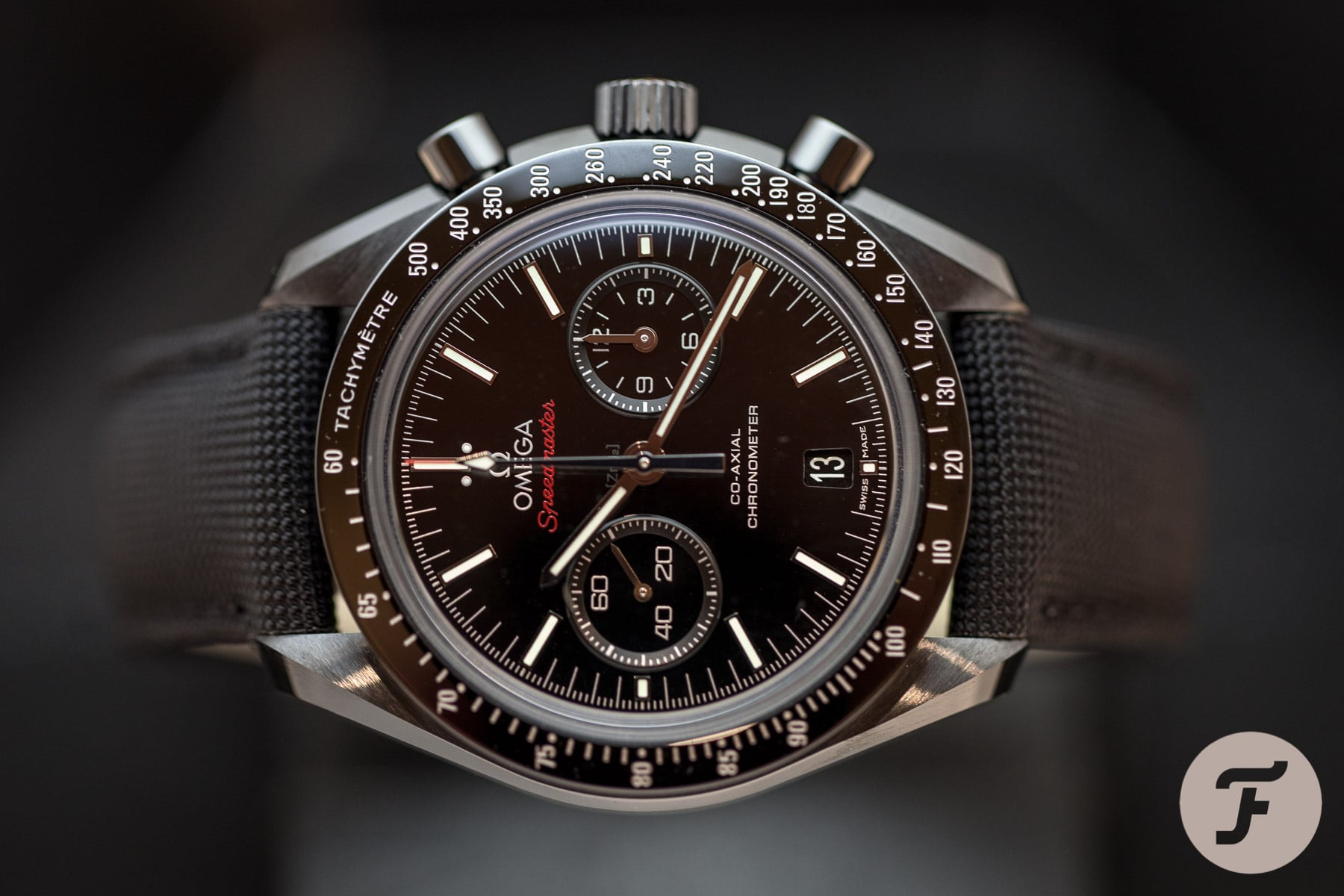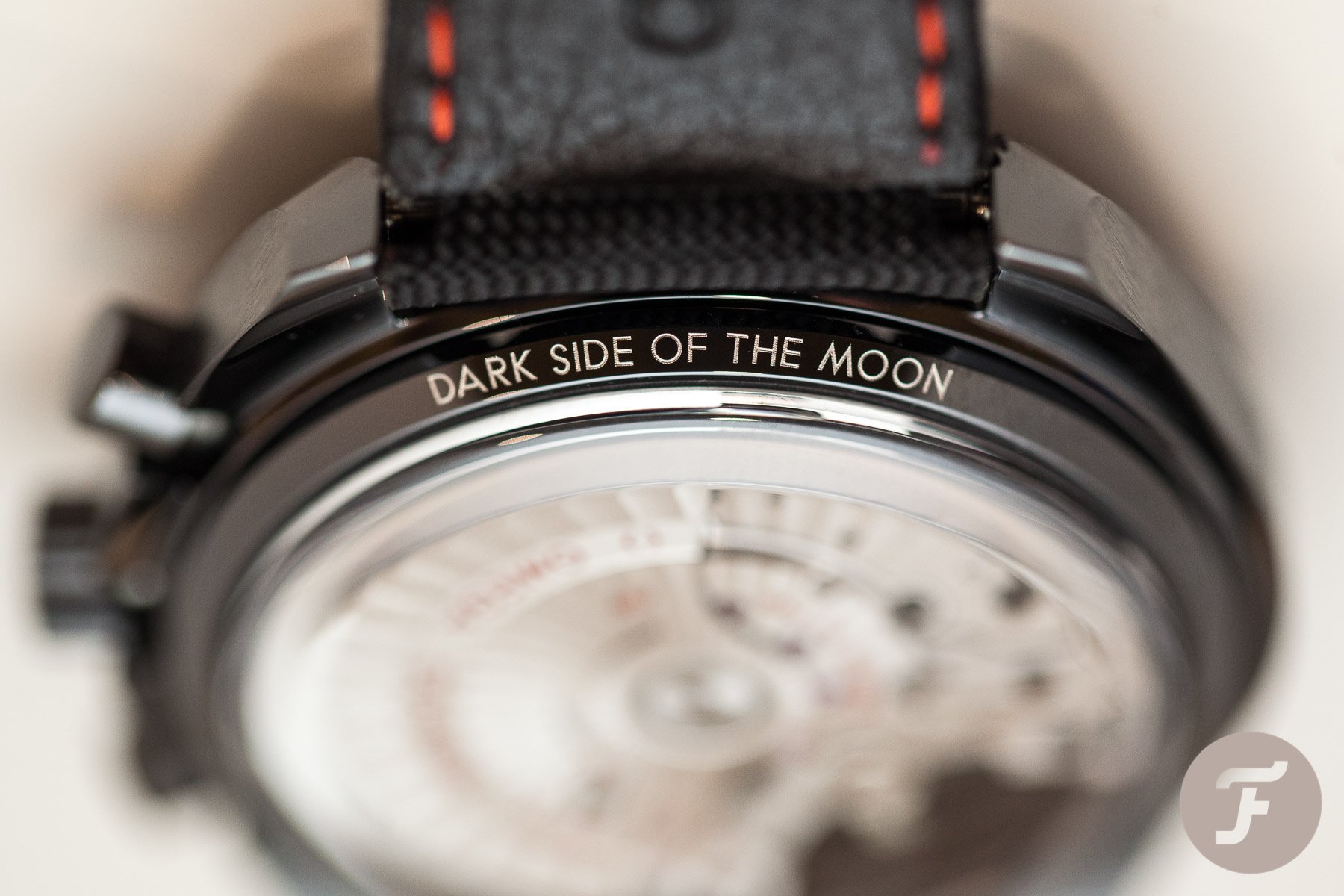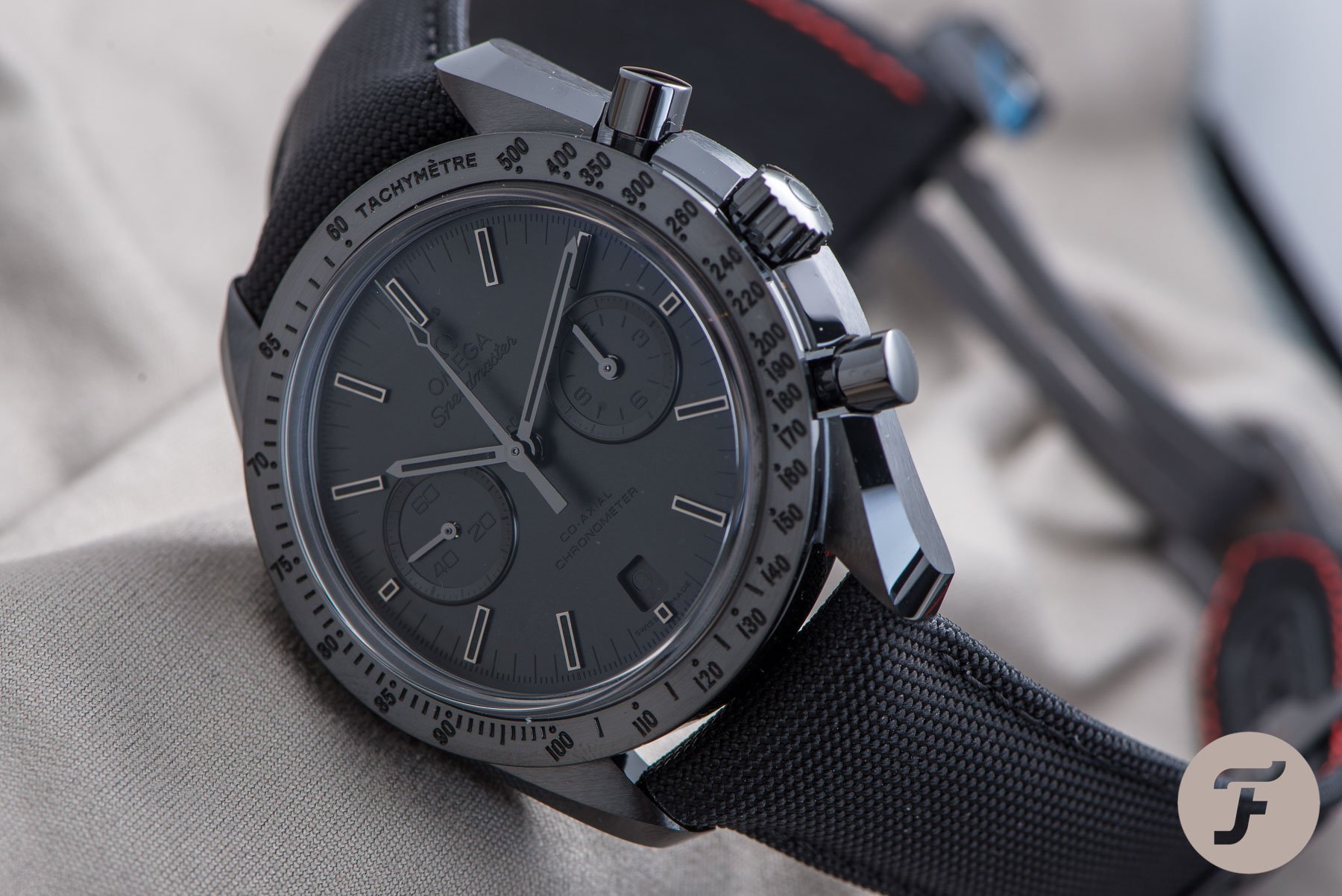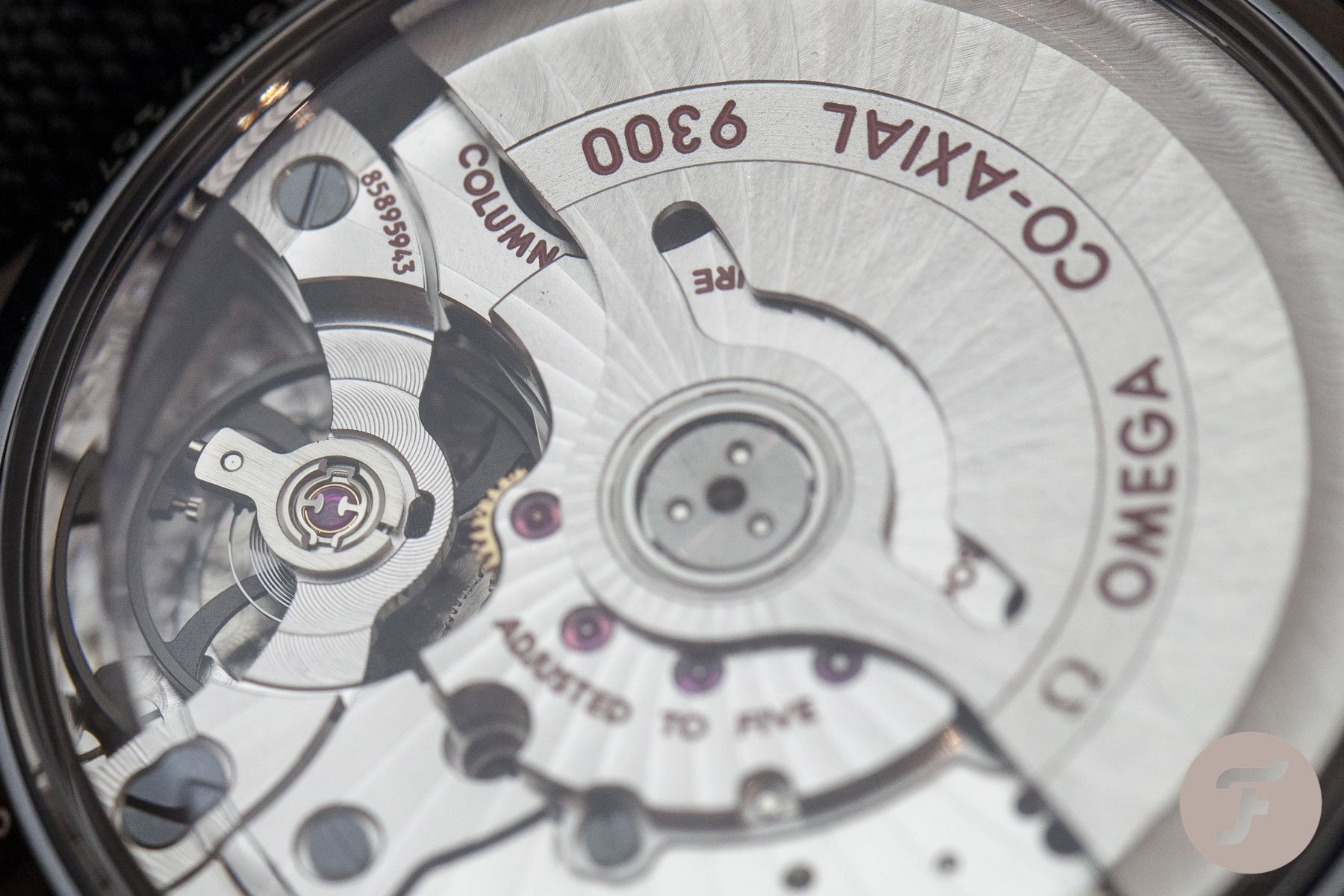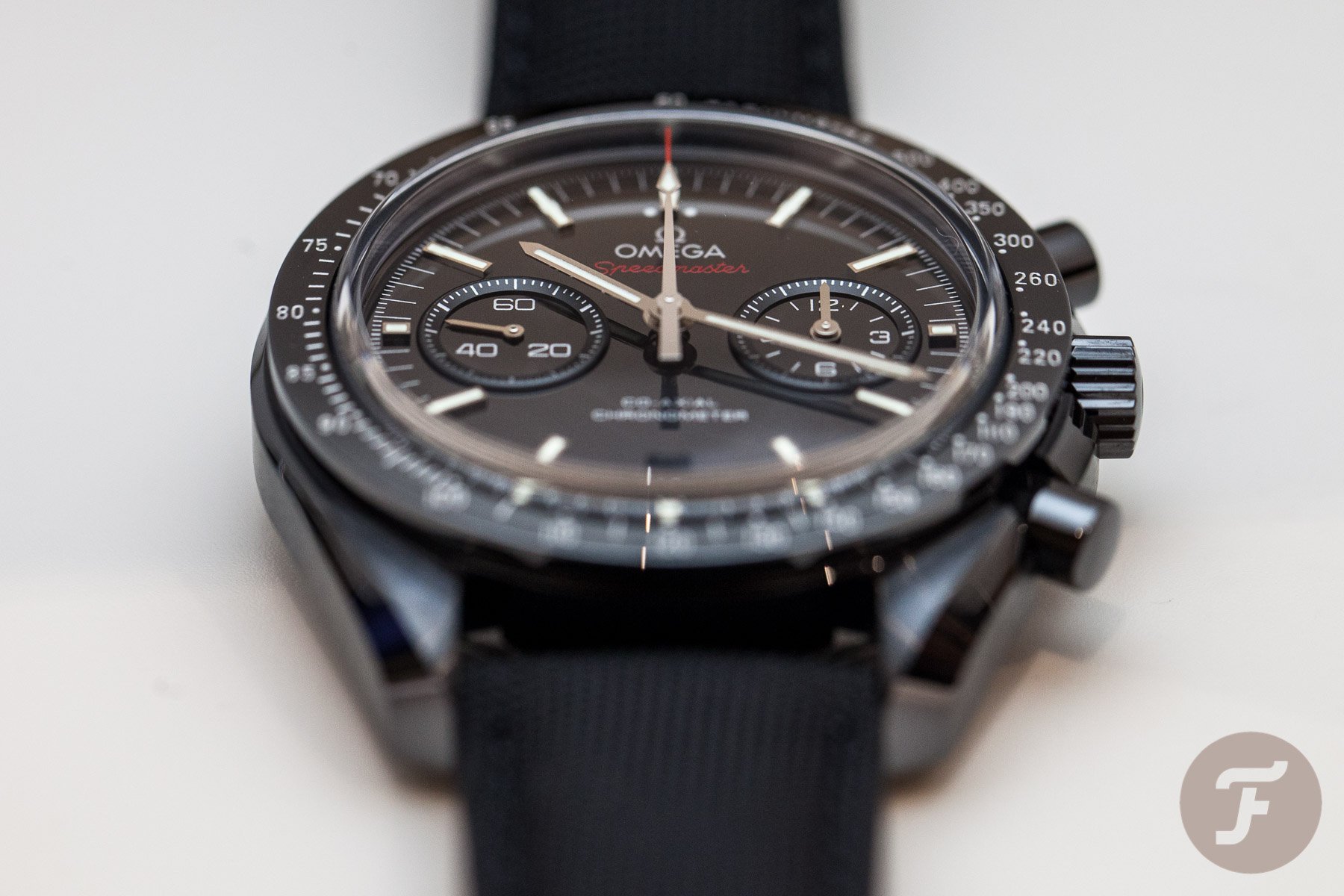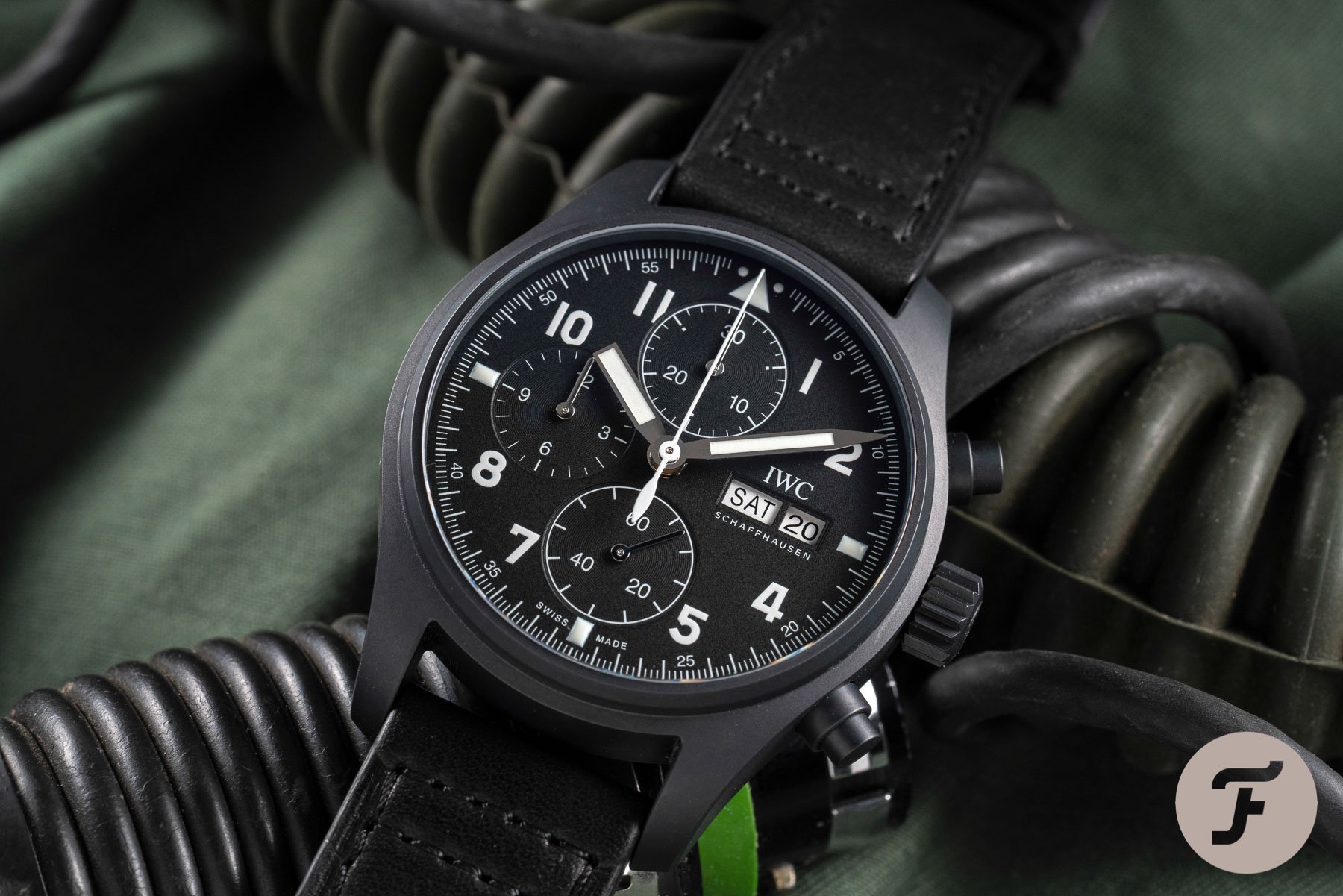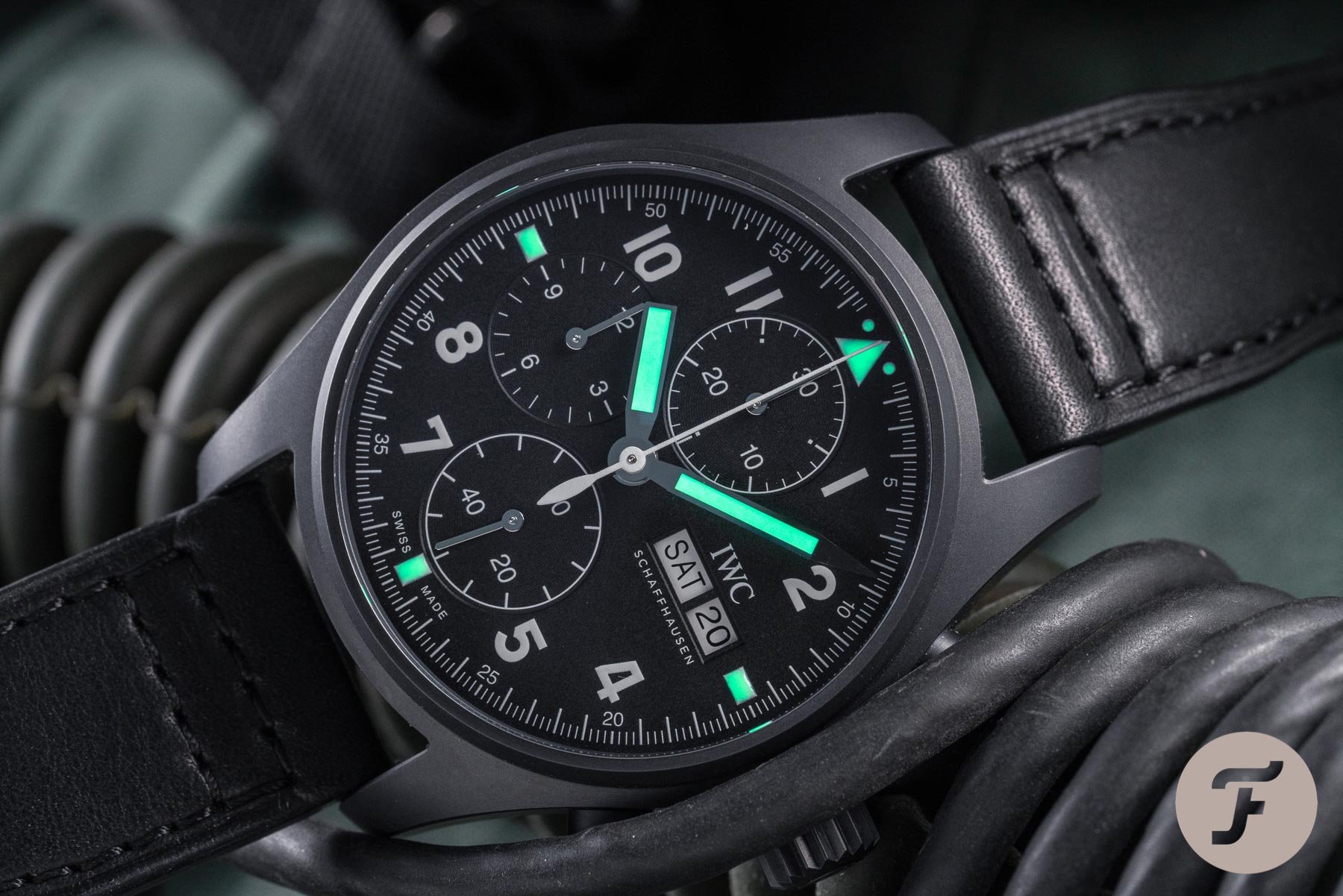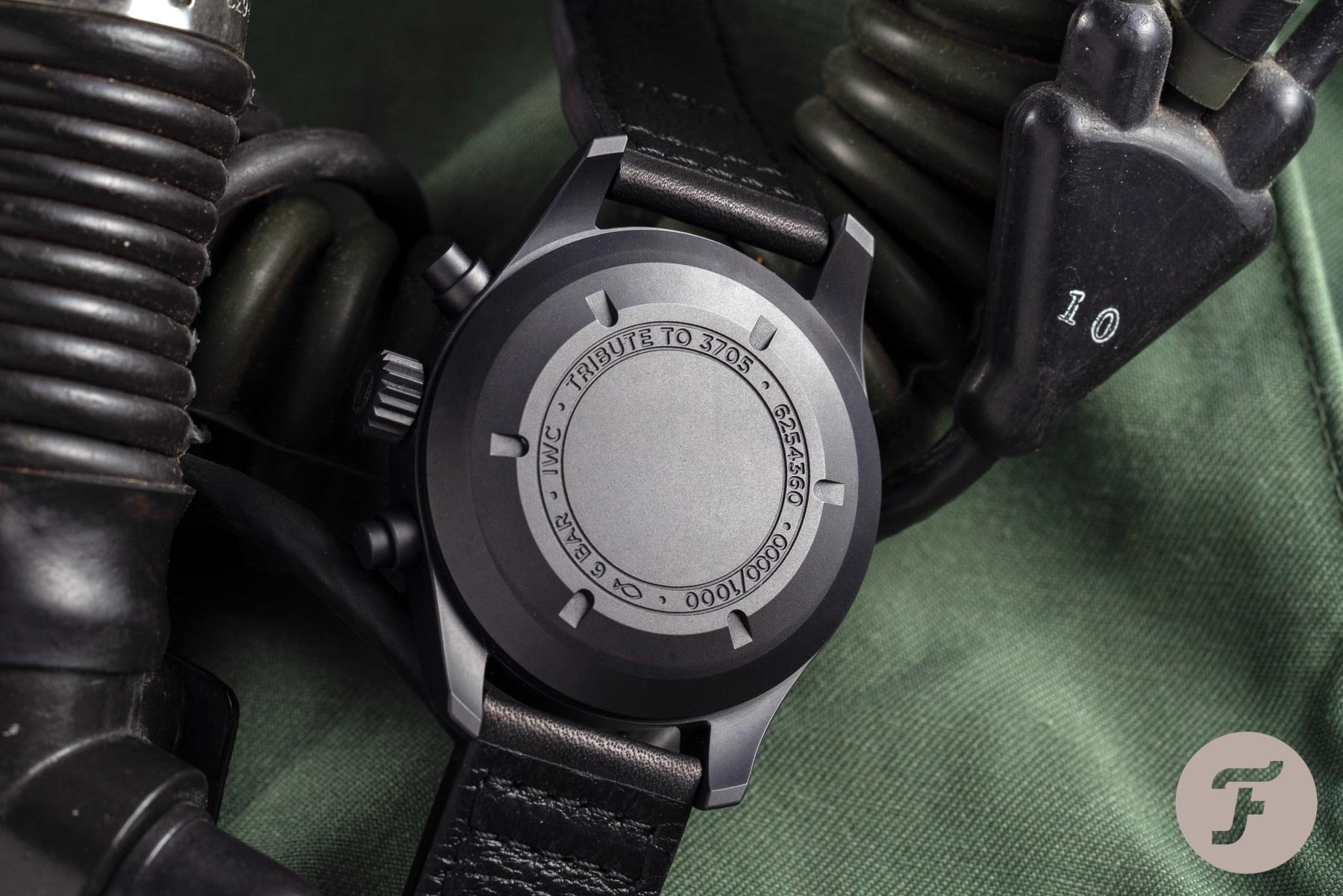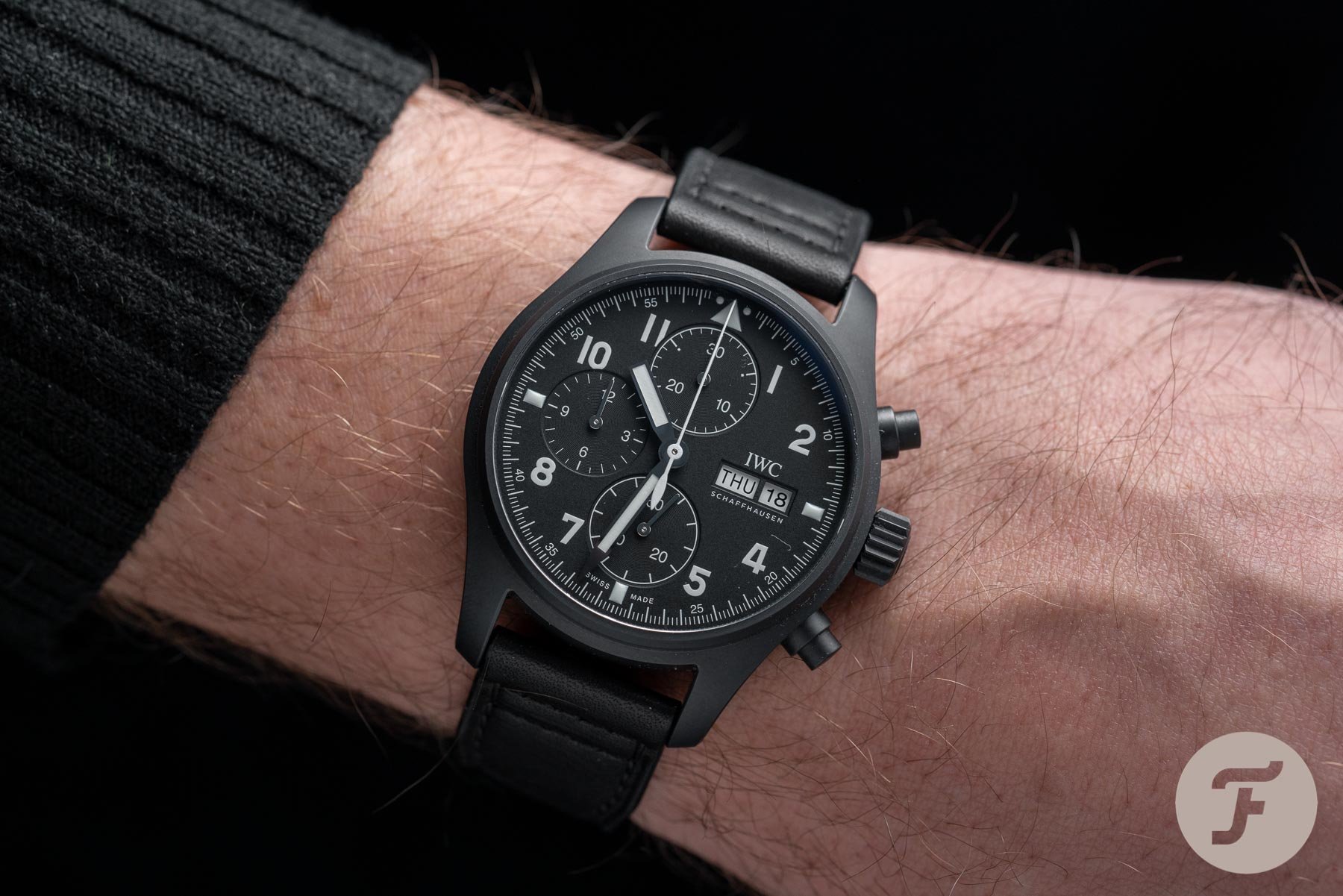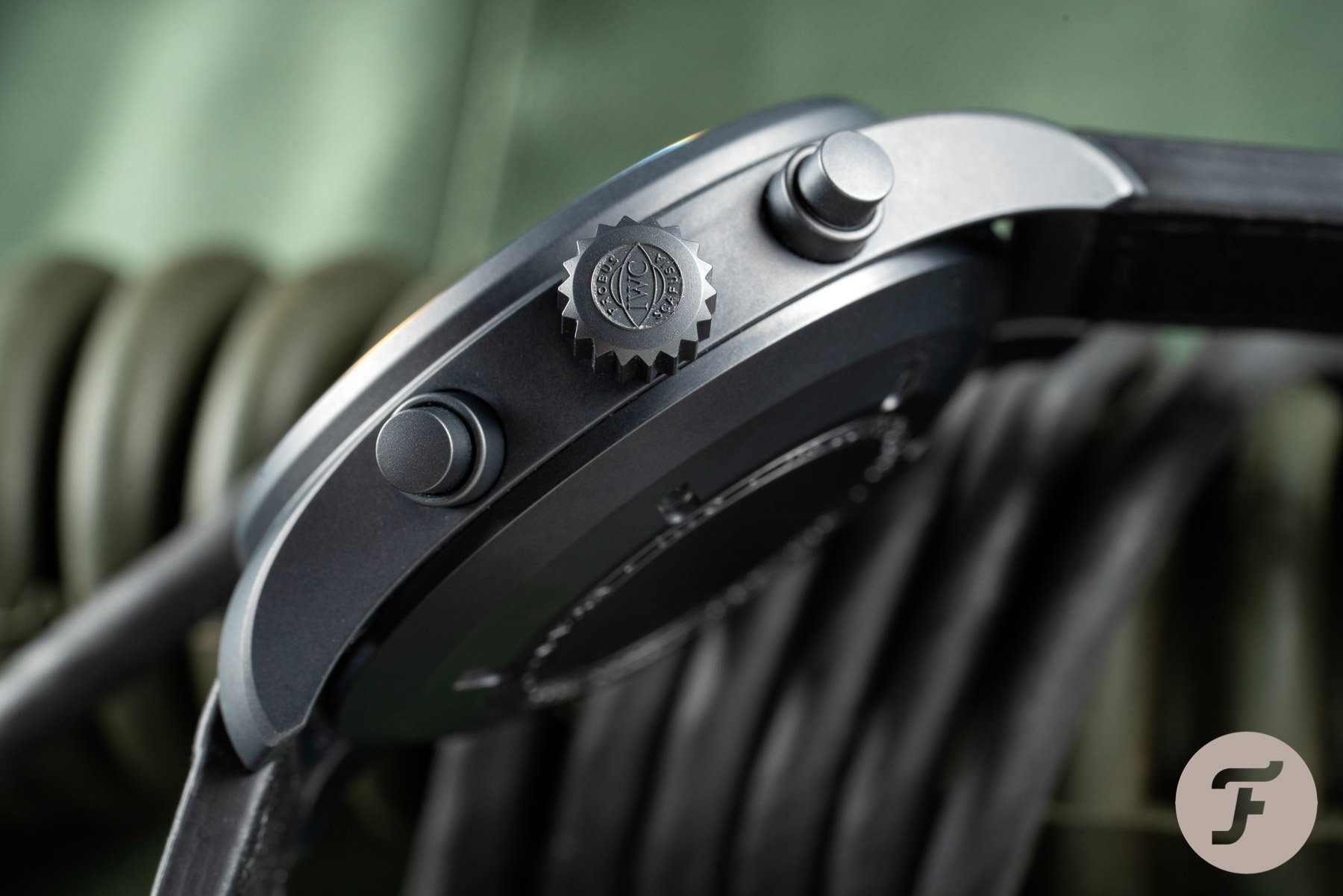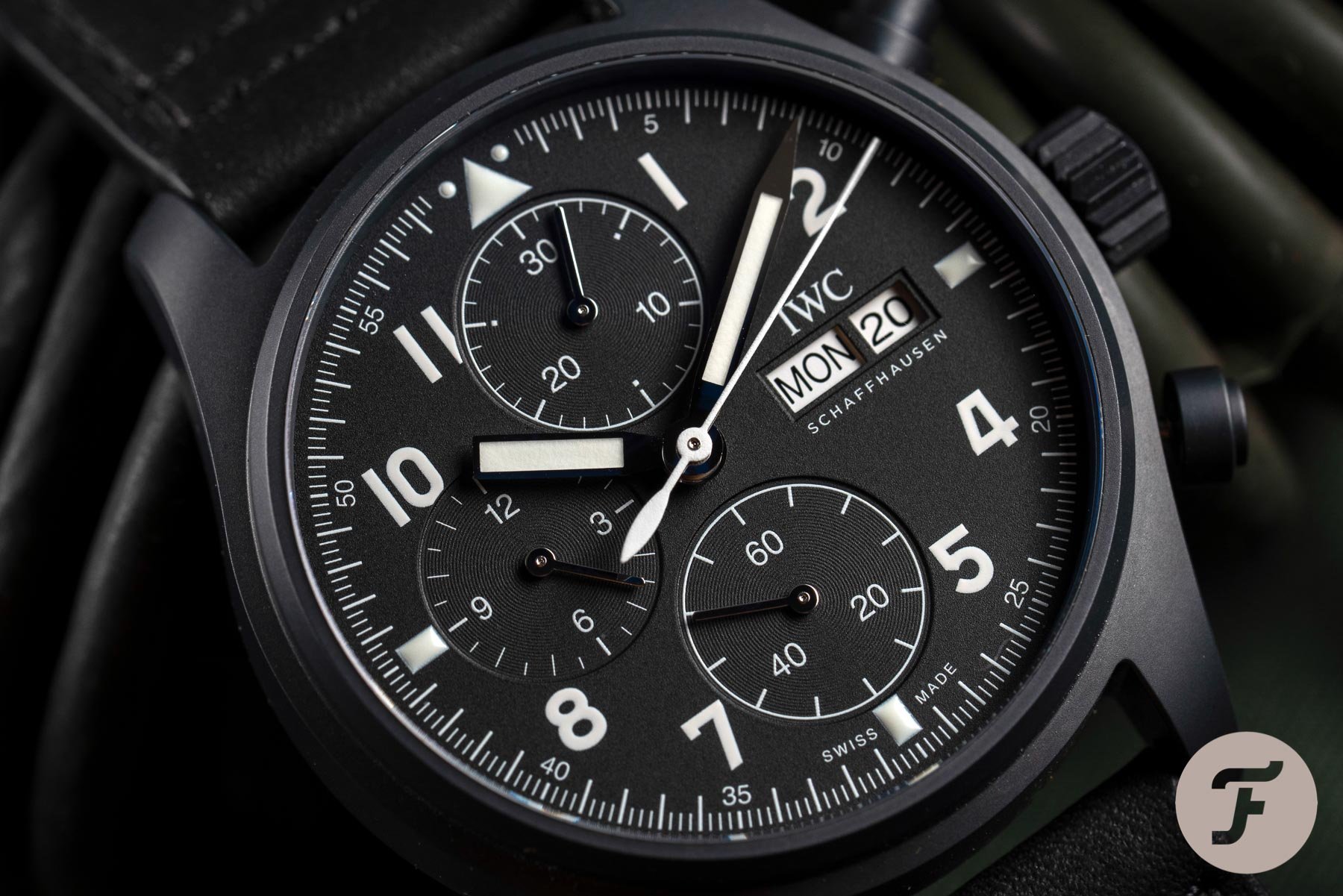Sunday Morning Showdown: Jet-Black Jaw-Droppers — Omega Vs. IWC
In our Sunday Morning Showdown, two of our writers go head-to-head in an epic showdown for the ages. Strong opinions and hysterical hyperbole are welcome (so feel free to join in with the fun in the comments section below). And don’t forget to let us know which watches you’d like to see torn to shreds/effusively exalted next week. We’ll try and feature as many of our readers’ choices as we can. This time, two top echelon chronographs trade blows. The Omega Speedmaster Dark Side Of The Moon in ceramic and the IWC Pilot’s Chronograph “Tribute To 3705” in Ceratanium.
In some ways, these watches sit at opposing ends of the spectrum. The recently-announced IWC Pilot’s Chronograph pays tribute to the ’90s reference 3705. Yet, despite the lineage in the Speedmaster’s long and storied history, the Dark Side of the Moon feels thoroughly cutting-edge. They may span the eras of inspiration, but the Omega DSotM and the IWC Fliegerchronograph share a common ethos: Blacked-out, scratch-resistant chronographs with in-house automatic movements.
Looking back at last week, and we also had an evenly-matched duel. The Sinn and Fortis chronographs see-sawed over the week. The Sinn took the early lead, but the Fortis came fighting back and over-turned the result. At some point, we were preparing to announce the first tie as it lingered on 50% apiece for three days straight. In the end, the Sinn triumphed with a 54% share. It’s hard to say what tipped the scale with our readers, but perhaps the technology packed into the Sinn oozes innovation over the Fortis.
We also must include our favorite Sunday “pun-day” from commenter, Dadutchcollection.
“It would be a Sinn not to comment, after all, bad humor is my Fortis.”
The science of substance
Both the Omega and IWC excel in the progression of material science. Not only that, but the watches tap into the psyche of the modern consumer. No one could have predicted the success of the Dark Side of the Moon at launch in 2013. It was a bit like an offbeat cinematic masterpiece The Matrix, with its lofty ambitions landing with a fully engaged audience. The Dark Side of the Moon brought the potential with ceramic to the forefront. But, also like The Matrix, Omega went a little overboard with the sequels with the White Side of the Moon, Black Black, and so on. Even so, the zirconium oxide compound by Omega is one of the finest ceramics in the industry.
Coming at it from a different angle is the IWC Pilot’s Chronograph in Ceratanium. This “Tribute To 3705” may be in its early days, by only seeing the light since Thursday, but it is already stretching the demands of its 1,000 piece limitation and even the bandwidth of IWC’s servers for a brief period. IWC is releasing the allocation of this watch in blocks, but each batch is selling out fast as it is exclusively sold through the IWC’s e-boutique. The Ceratanium material draws the best of both worlds from the lightness and hardness of titanium and ceramic’s scratch resistance.
But let’s leave it to our writers to duke it out. After the dust settles, it’s up to you to vote for your preference.
Jorg — Omega Speedmaster Dark Side of the Moon
We are tapping into the power of the dark side this week. But before we do, a little look back at last week’s Showdown. It was so good to see that so many of you voted in our functional chronograph duel. I expected the Sinn to win a more significant margin, but it was still a close call. It’s good to see that so many of you appreciate the Fortis as much as I do. And honestly, its aesthetic also fits this week’s theme perfectly as the Fortis Official Cosmonauts Amadee-18 also succumbed to the dark side.
Bringing a Ceratanium knife to a ceramic gunfight…
A match-up against a Speedmaster is a death sentence in our Sunday Morning Showdown series, Ben. And I applaud you for having the courage to bring your Ceratanium knife to this ZrO2 gunfight. Especially against such a tremendous conceptual watch as the Omega Speedmaster Dark Side of the Moon. Not only is it a watch with a great story, but it’s also Omega’s take on the modern Speedmaster — in design, in the use of materials, and technique. But most of all, it steps out of the Moonwatch’s shadow and takes you on a trip through a black-hole.
The Dark Side of the Moon ceramic concept
Before I get into the Speedmaster Dark Side of the Moon details, I would like to take a quick look back at last year’s Fratello Speedmaster World Cup. One of our finalists was the Silver Snoopy 2015; a watch often praised for being the most abstract Speedmaster out there. And it has a great tale to tell with its comical dial that resonates with collectors. But for me, the Dark Side of the Moon is up there with the best Speedmaster special edition watches in conceptualizing a story.
“We’ll see you on the other side.”
The Speedmaster Dark Side of the Moon was introduced back at Baselworld in 2013 and stirred up quite a buzz. Omega combined the Apollo 8 astronauts’ story with the creation of a modern interpretation of the Speedmaster. The Apollo 8 astronauts were the first to lay eyes on the far side of the Moon just after Jim Lovell exclaimed, “We’ll see you on the other side.” In honor of the first time humans circled the Moon, Omega created the Speedmaster Dark Side of the Moon. The main element telling that story is the black ceramic case that proves to be the perfect canvas for a modern version of the Speedmaster.
How many sides of the Moon?
Soon after introducing the first Speedmaster Dark Side of the Moon, Omega introduced a full collection of “Side of the Moon” models. We saw a Vintage Black, a Sedna Black, a Pitch Black, and a Black Black. On top of that, Omega also brought a White Side of the Moon, two Blue Side of the Moon models, and two Grey Side of the Moon models. And more recently, Omega added the Apollo 8 and Alinghi.
Ben: Omega milked that concept dry to the point it lost its original intention.
Unfortunately, yes, this capitalization of the concept clouded the original idea’s strength and its initial execution. Although I must say that I love the Black Black version as it takes the idea to the utter extreme. Although hardly a practical watch, it shows what it truly means to be on the dark side. Even though the “dark” side of the Moon receives a fair amount of sunlight, but due to the Moon’s position being locked-in with Earth’s orbit, we could never see it from the surface — a phenomenon known as Tidal Locking. Hence, it’s more the darkness of our knowledge before Apollo 8 made a pioneering slingshot around the Moon.
The clouding of the original “Side of the Moon” concept diminished the impact with recurring watches. When you talk to enthusiasts, it’s unanimous that the original Speedmaster Dark Side of the Moon nailed its concept. I still remember viewing the watch for the first time at an event (remember those?) that Fratello and Omega organized back in 2014. One of the guests had just received his Dark Side of the Moon after the initial production delays and it was the star of the evening. The genuine excitement of seeing a full black ceramic Speedmaster with a co-axial movement was special.
Black ceramic case
The case of the Speedmaster Dark Side of the Moon is created from a single block of black zirconium oxide ceramic. And so are the crown, pushers, and the dial. Gerard perfectly explained the unique characteristics of the material in an installment of 52Mondayz discussing the Blue Side of the Moon. The hour markers and hands of the Dark Side of the Moon are made of 18k white gold and inset by hand with Super-LumiNova. The tip of the chronograph hand and the Speedmaster wording on the dial have accents in red to give the overall look just the right amount of color splash. The tachymeter scale is laser-etched and metalized in the polished black bezel. Lastly, the DSotM comes on a black nylon strap with red stitching on the inside and the choice of a ceramic buckle or a ceramic and titanium foldover clasp.
If you turn the watch around, you will see the automatic Omega Caliber 9300 in all its glory. This COSC-certified co-axial movement was first introduced in 2011. It’s a column-wheel chronograph that uses the Si14 balance spring and features sub-registers at 3 and 9 o’clock and a date indication at 6 o’clock. This creates a dial layout that is different from the Moonwatch. While some people dislike the Dark Side of the Moon for only having two sub-dials, I see it as a distinguishing characteristic. The Moonwatch and DSotM can both be Speedmasters with distinct angles of approach.
Achieving its potential
At 44.25mm, the case is slightly bigger than the regular 42mm Speedmaster. Some people argue this dimension limits the appeal. I don’t have a problem with the diameter at all. However, the case height of 16mm was where the real feeling of heft was felt. Despite the thickness, the black ceramic case optically appears smaller than the specifications suggest due to the stealthy lines. Ceramic also handles different on the wrist, and at 91 grams, the watch is effortless to wear. It almost makes you forget that the watch is bigger than the regular Moonwatch. But as I said, it’s not a matter of comparing the two.
Ben: From personal experience, it’s the height of the caliber 9300 in any watch case that puts me off the automatic in-house chronographs from Omega. It just feels like a hockey puck.
For me, the Speedmaster Dark Side of the Moon has perfectly shown that there is a lot of room for the Speedmaster to evolve. Creating the icon with different materials, a modern-day co-axial movement, and attaching the right story has proven to be a compelling statement. A statement that eight years later still feels as riveting as when it was introduced. And I wonder if the IWC Pilot’s Chronograph “Tribute To 3705” will ever be able to come close to that. For starters, I know that the Speedmaster is the more affordable option out of the two with a current list price of €11,600. But we both know that price is only one part of the equation.
So tell me more about this brand new IWC, Ben.
Ben — IWC Pilot’s Chronograph “Tribute To 3705”
I get it Jorg, it may be a surprise coming into Sunday Morning Showdown with such a fresh release, but when I first saw what was coming from IWC, I knew it was ripe for comparison. Perhaps the Breitling Navitimer would draw an instant correlation, but with the blacked-out case of Ceratanium, I view it slightly differently. In its steel form, the IWC Big Pilot or Pilot’s Chronograph has a distinct aviation flair. But in either the black ceramic or Ceratanium versions, the IWC fliegers have more of a lifestyle vibe. As Jorg points out, this opens up the floor to other ceramic chronographs that depart from their heritage such as the Omega Speedmaster Dark Side of the Moon.
Jorg: You might be surprised, Ben. I’m definitely intrigued because the Pilot’s Chronograph is one of those classic IWC models I actually like.
That shouldn’t lead you to believe I consider the IWC a fashion watch for showing off without the street-cred to back it up. Far from it, but neither is the “Tribute To 3705” a hardcore pilot’s watch that feels out of place in any scenario other than the cockpit. I envision it on a helicopter pilot’s wrist as they pull the visor down as much as a skater brushing their hair back over their shades — the “Tribute To 3705” evokes that level of versatility.
A history of material innovation by IWC
In the science of substance section above, we touched upon what makes both contenders in today’s showdown so resilient to the shocks and knocks of everyday wear. But what is distinct about the Ceratanium material here is that IWC may be at the forefront of the next material trend. Just by looking back at IWC’s metallurgic leaps, and we may be seeing history repeat itself. The Porsche Design Ocean 2000 Diver’s Watch by IWC in 1982 was the first fully titanium watch case and bracelet in production. Not long after this feat was the Da Vinci ref. 3755 in 1986, the first production watch with a ceramic case, albeit with gold extremities.
In the ’80s and ’90s, IWC bridged the gap from tool watches to artistic expressions of science and engineering.
This was IWC in its prime of leading the charge in how mechanical wristwatches can bridge the gap from essential tools to artistic expressions of science. The ’90s continued this trajectory with unfortunately diminishing returns. As big and as bold as the advertising was for the brand, it became a problematic era to capture a broad audience with the ethos of material magic alone. The reference 3705 was one of the last hurrahs for IWC to flex its muscles with a ceramic case in a more familiar Flieger chronograph format.
A ceramic cult classic
Still, even this more marketable watch barely scrapped sales under 2,000 from several years on the market. 2,000 is less than some limited edition models from big brands in our current mechanical renaissance. To combat this supposed misfire, IWC began producing even more marketable watches, that to me, move away from the core of the brand’s uniqueness. Dive watches such as the reference 3536 may have resurrected the Aquatimer name, but the results were too cookie-cutter in my eyes. Witnessing the Big Pilot’s return in reference 5002 in the early noughts gave me the hope that IWC would come back strong after a brief dip.
It goes to show the difference a few decades make as the reference IWC ref. 3705 Fliegerchronograph Keramik began heating up in the auction houses. Nineties nostalgia is indeed in full swing, and those who recall the watch in their youth bemoan a likewise timepiece in IWC’s current catalog. Perhaps these same buyers were responsible for the demand rising to at least €23,000, as RJ mentions in his hands-on review. As IWC reintroduce the design cues of the mid-90s pieces in a modern guise, it is not such a problem for collectors to reminisce.
Jorg: God, I feel old just reading this…
Ceratanium spreading its wings
This time, instead of ceramic, the Pilot’s Chronograph is cased in IWC’s proprietary Ceratanium. This is not the first use of the scratch-resistant substance. The 50th-anniversary special edition of the Aquatimer in 2017 received that honor with an ultra-expensive perpetual calendar digital date-month complication. More recently, Ceratanium found its way on the Hodinkee collaboration Pilot’s Watch Mark XVIII. Scaling back to a simplistic time-only watch spread broader awareness of Ceratanium and its exclusive properties. So what is Ceratanium, exactly?
It’s not a coating but instead a mixture of zirconium oxide and grade 2 titanium. Hence, the portmanteau name — but I would describe it more like a titanium alloy. It inhibits the qualities of ceramic’s scratch resistance and titanium’s lightness. The overall hardness is 1,000 Vickers, so easily able to withstand heavy hits without the risk of shattering to the effect of typical ceramic cases.
Last week, we had two Valjoux 7750-powered chronographs facing off. While the Tribute to 3705 may share the same geometry as the Valjoux 7750, and indeed its forebear, the Tribute is powered by the in-house manufacture caliber 69380. Despite the layout similarities, this is an entirely different mechanism. The most obvious variance is the migration of the subsidiary seconds position from 9 o’clock of the Valjoux to 6 o’clock. Less obvious is the bi-directional winding negating any issues of unbalanced wobbling of the 7750’s infamous rotor.
Is it a true tribute?
All these benefits excite me about the new IWC. I do think it’s a triumph for the brand, with just a small-set of caveats. Ok, there is one BIG caveat, but I’ll get to that. I think IWC could have done polished steel pushers as per the original. I understand if IWC were keen to showcase the technology of machining complicated components such as the pushers and crown in the more durable Ceratanium material — it’s a firm flex for sure and gives it a uniform design. However, the past model’s limitation of precision molding with ceramic has become somewhat of a signature and lends a real sense of nostalgia.
I also understand the day wheel is only available in English. I always respected the Swiss-German speaking team at Schaffhausen staunchly renaming its models in the German language. “Portuguese” became “Portugieser” for example, and I liked how the days of the week were available in German. Not having this option is no big deal, but again I am leaning on my nostalgic recollection of seeing “DIE” on the dial for Dienstag. Ok, I am stalling a bit as I now have to mention the cost of all this neo-vintage retro revival — it’s €12,800. A hefty sum to pay and double the price of the steel counterpart IWC Spitfire. But think of it like this, IWC pioneered the use of titanium and ceramic in the ’80s. Could Ceratanium be the next big thing in case materials, Jorg?
Final words
Jorg: That’s a good question, Ben. What I like about the “Tribute To 3705” is that it reminds us of a time that IWC was creating great watches and pushed the boundaries of watchmaking. It’s hard to forget the brilliance of the Il Destriero Scafusia. But what I’m stuck with is the thought that just the material itself and the fact that this is a one-off limited edition doesn’t bring back the glory days of the brand. It’s merely a reminder of it.
And that’s where the Speedmaster Dark Side of the Moon does a much better job than the “Tribute To 3705”. Sure, it’s easy for Omega to use the stories of the travels to the Moon. But they have also succeeded to connect to different moments in space-faring history by using new materials, new designs, and utilizing co-axial automatic movements. And it’s why I much prefer the Speedmaster Dark Side of the Moon.
Ben: Omega may have perfected the use of ceramic, but the risk of shattering still hangs over the brittle nature of the material. In that regard, I view IWC as blazing the trail with Ceratanium. Sure, it comes with a premium at this point and only available in limited editions. But it highlights the broadening possibilities of this new alloy. Just like IWC achieved with titanium and ceramic beforehand.
There you have it. Two chronographs that explore a trip to the dark side. But which of the two will be your preferred choice? Vote below and let us know your reasoning in the comments.

